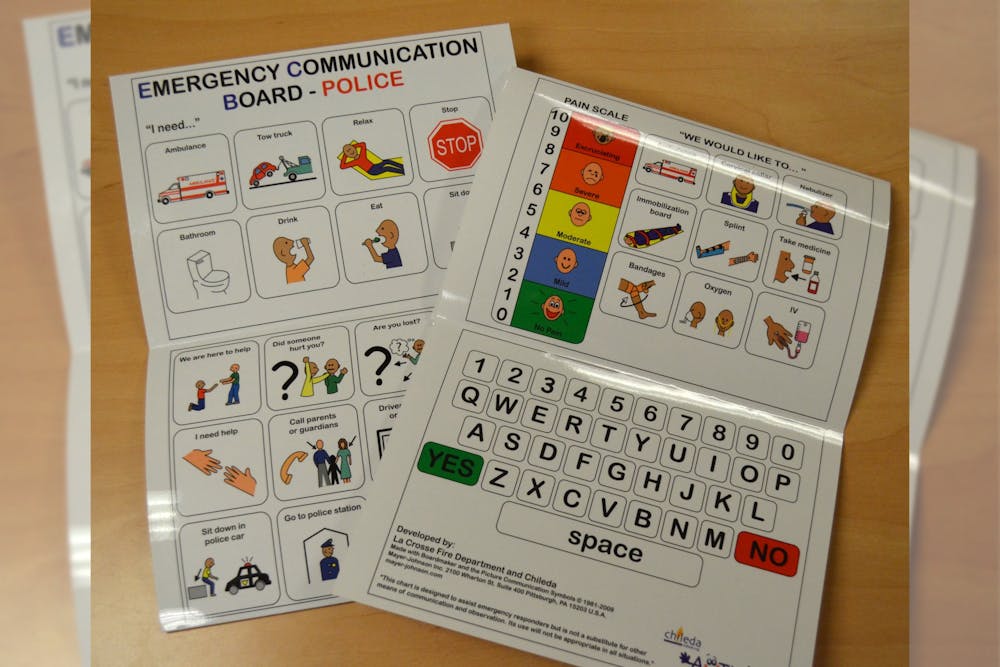The Indiana University Police Department will receive picture communication boards to help its officers better communicate with non-verbal individuals or those who may not speak English. The boards are part of a project funded by a grant from the Psi Iota Xi sorority.
Emergency communication boards are visual tools intended to assist emergency personnel in communicating with people who are not responding to verbal instructions or questions, according to Chileda, a living learning center dedicated to helping children with cognitive and behavioral challenges.
“Oftentimes, if you're an individual with autism, and when you're in a situation that's very stressful, then you're not able to produce the language that you need,” Kristie Brown Lofland, a speech pathologist and autism consultant, said.
The communication boards will be provided to all law enforcement agencies and first responders in Monroe County through a grant from the Psi Iota Xi sorority, a philanthropic organization that supports speech and hearing issues.
Lofland learned about the Psi Iota Xi grant from a friend of hers who is a member. The friend asked Lofland to come up with an idea to use the grant for a cause relating to autism.
Related: [IUSG executive branch candidates discussed branch relations, representation at Friday debate]
Lofland’s background is in speech language pathology, and she’s trained first responders in interacting with people with autism. She came up with the idea to supply law enforcement agencies and first responders with picture communication boards after her neighbor’s autistic child left home without his parents’ knowledge. Lofland said a city worker found the young boy and called the police. The boy could not communicate with the police officer.
Lofland said another neighbor happened to be walking the neighborhood, saw what was going on and was able to show officers where the boy lived.
“I'm watching this unfold, I'm like dang I wish they had a communication board or a way that they could communicate with him better so that he can understand what they wanted,” Lofland said.
Lofland contacted all the police agencies in Monroe County, the Ellettsville and Bloomington fire departments, the Indiana State Police and the IU Health ambulance service about the idea.
“Everybody responded favorably and said, ‘Oh my gosh, this is a tool we can really use,’” Lofland said.
The grant project is working with two companies, the Autism Channel and Crisis Prevention Institution, to make the boards, Lofland said.
Lofland said she plans to purchase 200 boards for Monroe County. It costs about $30 for 10 boards, and she’s receiving $750 from the Psi Iota Xi grant.
Related: [Protestors condemn Russia’s attack against Ukraine, stand in solidarity against violence]
IUPD requested 12 boards, Bloomington Chief of Police Jill Lees said. This means there will be a board in each of their nine vehicles and three in the IUPD building.
Lees said she wants to ask IUPD’s Major of Public Safety Training and Education to incorporate the communication boards into their annual training.
“I just don't want to throw them in the cars and say, ‘Hey, there's communication boards out there, right?’” Lees said. “There's a way to incorporate that training to give an officer a refresher and how these boards can be really vital to different investigations.”
The communication boards are another tool that will better help IUPD provide the best service possible, Lees said. Lees said IUPD is good at connecting people to resources, and the boards will enable them to communicate with someone rather than contacting dispatch and asking for a sign language interpreter.
Related: [‘The future is ours to shape’: Mayor John Hamilton gives seventh State of the City address]
Alexus Lucas, co-president of the Neurodiversity Coalition at IU, said having communication boards could save lives.
“Having accommodations in law enforcement interactions really could be the difference between a situation that should just be a basic encounter and a situation that could be dire,” Lucas said.
Communication boards are just one tool in the larger scheme of bridging the gap between officers and the neurodiverse community, Lucas said.
“It can ease anxiety, and knowing that you have other options to communicate,” Lucas said.
Currently, the Psi Iota Xi grant only covers Monroe County, but Lofland is trying to get grants to provide communication boards to law enforcement agencies and first responders across the state.
“There's a lot of reasons that I'm excited about bringing that together,” Lofland said. “But most of all, to be able to help individuals who can't verbally communicate at the time and need help.”






